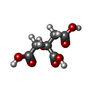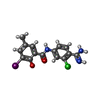[English] 日本語
 Yorodumi
Yorodumi- PDB-1gjd: ENGINEERING INHIBITORS HIGHLY SELECTIVE FOR THE S1 SITES OF SER19... -
+ Open data
Open data
- Basic information
Basic information
| Entry | Database: PDB / ID: 1gjd | ||||||
|---|---|---|---|---|---|---|---|
| Title | ENGINEERING INHIBITORS HIGHLY SELECTIVE FOR THE S1 SITES OF SER190 TRYPSIN-LIKE SERINE PROTEASE DRUG TARGETS | ||||||
 Components Components | (UROKINASE-TYPE PLASMINOGEN ACTIVATOR) x 2 | ||||||
 Keywords Keywords | BLOOD CLOTTING / hydrolase / selectivity at S1 / H2O displacement / uPA / tPA / Ser190/Ala190 protease / structure-based drug design | ||||||
| Function / homology |  Function and homology information Function and homology informationu-plasminogen activator / regulation of smooth muscle cell-matrix adhesion / urokinase plasminogen activator signaling pathway / regulation of plasminogen activation / regulation of fibrinolysis / regulation of wound healing / protein complex involved in cell-matrix adhesion / regulation of signaling receptor activity / negative regulation of plasminogen activation / serine-type endopeptidase complex ...u-plasminogen activator / regulation of smooth muscle cell-matrix adhesion / urokinase plasminogen activator signaling pathway / regulation of plasminogen activation / regulation of fibrinolysis / regulation of wound healing / protein complex involved in cell-matrix adhesion / regulation of signaling receptor activity / negative regulation of plasminogen activation / serine-type endopeptidase complex / regulation of smooth muscle cell migration / Dissolution of Fibrin Clot / smooth muscle cell migration / plasminogen activation / regulation of cell adhesion mediated by integrin / tertiary granule membrane / negative regulation of fibrinolysis / regulation of cell adhesion / specific granule membrane / serine protease inhibitor complex / fibrinolysis / chemotaxis / blood coagulation / regulation of cell population proliferation / response to hypoxia / positive regulation of cell migration / external side of plasma membrane / serine-type endopeptidase activity / focal adhesion / Neutrophil degranulation / cell surface / signal transduction / proteolysis / extracellular space / extracellular exosome / extracellular region / plasma membrane Similarity search - Function | ||||||
| Biological species |  Homo sapiens (human) Homo sapiens (human) | ||||||
| Method |  X-RAY DIFFRACTION / X-RAY DIFFRACTION /  FOURIER SYNTHESIS / Resolution: 1.75 Å FOURIER SYNTHESIS / Resolution: 1.75 Å | ||||||
 Authors Authors | Katz, B.A. / Sprengeler, P.A. / Luong, C. / Verner, E. / Spencer, J.R. / Breitenbucher, J.G. / Hui, H. / McGee, D. / Allen, D. / Martelli, A. / Mackman, R.L. | ||||||
 Citation Citation |  Journal: Chem.Biol. / Year: 2001 Journal: Chem.Biol. / Year: 2001Title: Engineering inhibitors highly selective for the S1 sites of Ser190 trypsin-like serine protease drug targets. Authors: Katz, B.A. / Sprengeler, P.A. / Luong, C. / Verner, E. / Elrod, K. / Kirtley, M. / Janc, J. / Spencer, J.R. / Breitenbucher, J.G. / Hui, H. / McGee, D. / Allen, D. / Martelli, A. / Mackman, R.L. | ||||||
| History |
|
- Structure visualization
Structure visualization
| Structure viewer | Molecule:  Molmil Molmil Jmol/JSmol Jmol/JSmol |
|---|
- Downloads & links
Downloads & links
- Download
Download
| PDBx/mmCIF format |  1gjd.cif.gz 1gjd.cif.gz | 130.5 KB | Display |  PDBx/mmCIF format PDBx/mmCIF format |
|---|---|---|---|---|
| PDB format |  pdb1gjd.ent.gz pdb1gjd.ent.gz | 103.5 KB | Display |  PDB format PDB format |
| PDBx/mmJSON format |  1gjd.json.gz 1gjd.json.gz | Tree view |  PDBx/mmJSON format PDBx/mmJSON format | |
| Others |  Other downloads Other downloads |
-Validation report
| Summary document |  1gjd_validation.pdf.gz 1gjd_validation.pdf.gz | 767.2 KB | Display |  wwPDB validaton report wwPDB validaton report |
|---|---|---|---|---|
| Full document |  1gjd_full_validation.pdf.gz 1gjd_full_validation.pdf.gz | 775.6 KB | Display | |
| Data in XML |  1gjd_validation.xml.gz 1gjd_validation.xml.gz | 17 KB | Display | |
| Data in CIF |  1gjd_validation.cif.gz 1gjd_validation.cif.gz | 24.3 KB | Display | |
| Arichive directory |  https://data.pdbj.org/pub/pdb/validation_reports/gj/1gjd https://data.pdbj.org/pub/pdb/validation_reports/gj/1gjd ftp://data.pdbj.org/pub/pdb/validation_reports/gj/1gjd ftp://data.pdbj.org/pub/pdb/validation_reports/gj/1gjd | HTTPS FTP |
-Related structure data
| Related structure data |  1gj4C  1gj5C 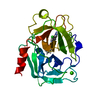 1gj6C  1gj7C  1gj8C  1gj9C  1gjaC  1gjbC  1gjcC C: citing same article ( |
|---|---|
| Similar structure data |
- Links
Links
- Assembly
Assembly
| Deposited unit | 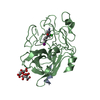
| ||||||||||
|---|---|---|---|---|---|---|---|---|---|---|---|
| 1 |
| ||||||||||
| Unit cell |
|
- Components
Components
| #1: Protein/peptide | Mass: 2708.183 Da / Num. of mol.: 1 / Fragment: SHORT CHAIN Source method: isolated from a genetically manipulated source Source: (gene. exp.)  Homo sapiens (human) / Description: P.PASTORIS / Plasmid: PPIC9LMWUPA / Production host: Homo sapiens (human) / Description: P.PASTORIS / Plasmid: PPIC9LMWUPA / Production host:  | ||||||||
|---|---|---|---|---|---|---|---|---|---|
| #2: Protein | Mass: 28435.428 Da / Num. of mol.: 1 / Fragment: CATALYTIC DOMAIN / Mutation: N145A Source method: isolated from a genetically manipulated source Source: (gene. exp.)  Homo sapiens (human) / Description: P.PASTORIS / Plasmid: PPIC9LMWUPA / Production host: Homo sapiens (human) / Description: P.PASTORIS / Plasmid: PPIC9LMWUPA / Production host:  | ||||||||
| #3: Chemical | | #4: Chemical | ChemComp-136 / | #5: Water | ChemComp-HOH / | Has protein modification | Y | Sequence details | For the listed sequence conflict, See Chem.Biol. 7, 299-312, 2000 | |
-Experimental details
-Experiment
| Experiment | Method:  X-RAY DIFFRACTION / Number of used crystals: 1 X-RAY DIFFRACTION / Number of used crystals: 1 |
|---|
- Sample preparation
Sample preparation
| Crystal | Density Matthews: 1.97 Å3/Da / Density % sol: 37.56 % | ||||||||||||||||||||||||||||||
|---|---|---|---|---|---|---|---|---|---|---|---|---|---|---|---|---|---|---|---|---|---|---|---|---|---|---|---|---|---|---|---|
| Crystal grow | Temperature: 298 K / Method: vapor diffusion / pH: 6.5 Details: 2-propanol, PEG 4000, pH 6.5, vapor diffusion at 298 K, pH 6.50 | ||||||||||||||||||||||||||||||
| Crystal grow | *PLUS pH: 7.4 / Method: vapor diffusion, hanging drop / Details: Katz, B.A., (2000) Chem.Biol., 7, 299. | ||||||||||||||||||||||||||||||
| Components of the solutions | *PLUS
|
-Data collection
| Diffraction | Mean temperature: 298 K |
|---|---|
| Diffraction source | Source:  ROTATING ANODE / Type: RIGAKU RU200 / Wavelength: 1.5418 ROTATING ANODE / Type: RIGAKU RU200 / Wavelength: 1.5418 |
| Detector | Type: RIGAKU RAXIS IV / Detector: IMAGE PLATE / Date: Sep 24, 1999 |
| Radiation | Protocol: SINGLE WAVELENGTH / Monochromatic (M) / Laue (L): M / Scattering type: x-ray |
| Radiation wavelength | Wavelength: 1.5418 Å / Relative weight: 1 |
| Reflection | Resolution: 1.36→23.03 Å / Num. all: 53462 / Num. obs: 19907 / % possible obs: 37.2 % / Observed criterion σ(I): 1 / Redundancy: 1.8 % / Rmerge(I) obs: 0.091 / Net I/σ(I): 5.5 |
| Reflection shell | Resolution: 1.7→1.85 Å / Rmerge(I) obs: 0.225 / Num. unique all: 2072 / % possible all: 27.9 |
| Reflection | *PLUS Num. obs: 16414 |
| Reflection shell | *PLUS Highest resolution: 1.75 Å / Lowest resolution: 1.83 Å |
- Processing
Processing
| Software |
| ||||||||||||||||||||
|---|---|---|---|---|---|---|---|---|---|---|---|---|---|---|---|---|---|---|---|---|---|
| Refinement | Method to determine structure:  FOURIER SYNTHESIS / Resolution: 1.75→7 Å / Cross valid method: THROUGHOUT / σ(F): 1.8 / Stereochemistry target values: X-PLOR force field FOURIER SYNTHESIS / Resolution: 1.75→7 Å / Cross valid method: THROUGHOUT / σ(F): 1.8 / Stereochemistry target values: X-PLOR force fieldDetails: Only Pro_A5 to Thr_A17 are included for the A-chain. Residues prior and after these residues are not visible (disordered). Residues after Thr_B242 are not visible (disordered). Residues ...Details: Only Pro_A5 to Thr_A17 are included for the A-chain. Residues prior and after these residues are not visible (disordered). Residues after Thr_B242 are not visible (disordered). Residues simultaneously refined in two or more conformations are: Met_B47, Met_B81, Ser_B95, Glu_B110B, Thr_B139, Met_B207, Leu_B235 Disordered waters are: HOH516 which is close to HOH517 HOH1081 which is close to HOH1082 No energy terms between citrate 1 and 2 are included because they are hydrogen-bonded to one another via an unusually short hydrogen bond between carboxylate / hydroxyl groups.
| ||||||||||||||||||||
| Refinement step | Cycle: LAST / Resolution: 1.75→7 Å
| ||||||||||||||||||||
| Refine LS restraints |
| ||||||||||||||||||||
| Refinement | *PLUS Highest resolution: 2 Å / % reflection Rfree: 10 % / Rfactor obs: 0.166 / Rfactor Rfree: 0.188 / Rfactor Rwork: 0.166 | ||||||||||||||||||||
| Solvent computation | *PLUS | ||||||||||||||||||||
| Displacement parameters | *PLUS | ||||||||||||||||||||
| LS refinement shell | *PLUS Highest resolution: 1.75 Å / Lowest resolution: 1.83 Å / Rfactor Rwork: 0.18 / Rfactor obs: 0.18 |
 Movie
Movie Controller
Controller


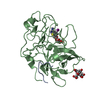
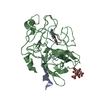




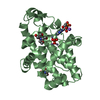
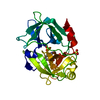
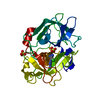

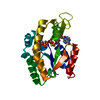
 PDBj
PDBj

